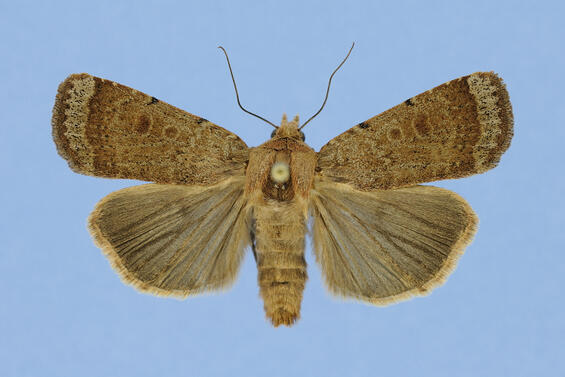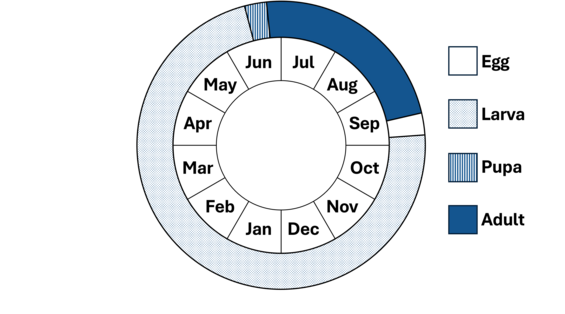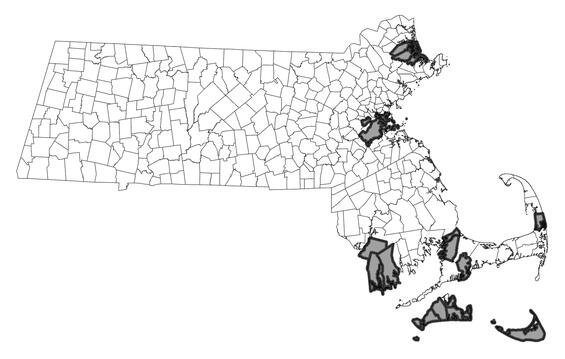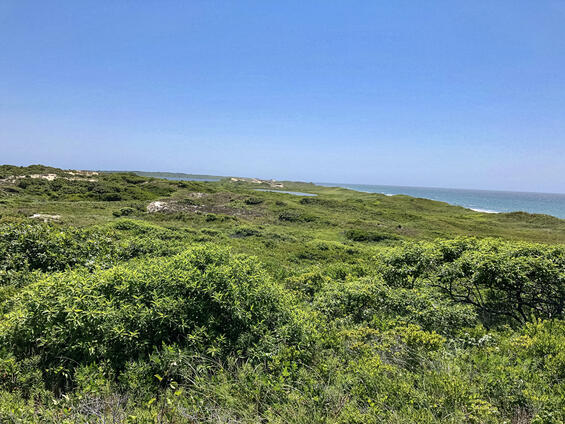- Scientific name: Abagrotis benjamini
- Species of Greatest Conservation Need (MA State Wildlife Action Plan)
- Special Concern (MA Endangered Species Act)
Description

Coastal heathland cutworm (Abagrotis benjamini)
The coastal heathland cutworm (Abagrotis benjamini) is a noctuid moth with a forewing length of 13-16 mm (0.5-0.6 in; Lafontaine 1998). The forewing ground color is reddish-brown, the outer margin frosted with a band of pale gray; there are two black wedges at the costal margin, one above the reniform spot and another above the antemedial line. The postmedial and antemedial lines are obscure, consisting of scales slightly paler than the ground color. The reniform and orbicular spots range from faintly to prominently darker than the ground color. The hind wing is grayish-brown, darker toward the outer margin, with an obscure discal spot. The head and thorax are concolorous with the forewing ground color, and the abdomen is concolorous with the hind wing.
Life cycle and behavior

In Massachusetts, coastal heathland cutworm moths emerge from late June through July, with summer-aestivating individuals flying through mid-September. Larvae overwinter partially grown, resume feeding in the spring, and pupate in June. Beach plum (Prunus maritima) is the preferred larval host plant in Massachusetts (Goldstein & Nelson 2017); other plants, especially in the rose family (Rosaceae), are likely fed upon as well.
Distribution and abundance
The coastal heathland cutworm is found on the Atlantic coastal plain from New Brunswick south to New Jersey (Lafontaine 1998). In Massachusetts it occurs along much of the coast, including the North Shore south to Boston, on Cape Cod and the offshore islands, and along the coast of Buzzards Bay.

Distribution in Massachusetts.
1999-2024
Based on records in the Natural Heritage Database.
Habitat
In Massachusetts, the coastal heathland cutworm inhabits open coastal habitats on sandy soil, including dunes and bluffs, sandplain grasslands and heathlands, other maritime shrublands, and occasionally similar open areas in pitch pine-scrub oak barrens.
Healthy habitats are vital for supporting native wildlife and plants. Explore habitats and learn about conservation and restoration in Massachusetts.

Maritime shrubland on dunes, habitat for the coastal heathland cutworm. Habitat managed by Martha's Vineyard Land Bank at Red Gate Farm.
Threats
The coastal heathland cutworm is threatened by habitat loss and fire suppression. Other potential threats include coastal dune nourishment, introduced generalist parasitoids, aerial insecticide spraying, non-target herbicide application, and off-road vehicles. This species is vulnerable to climate change; it is endemic to the northern Atlantic coastal plain and threatened by both warming temperatures and sea level rise.
Conservation
Land protection and habitat management are the primary conservation needs of the coastal heathland cutworm in Massachusetts. In particular, coastal dunes and bluffs, sandplain grasslands and heathlands, and other maritime shrublands should be conserved, restored, and managed to maintain habitat for this species and other species dependent on such habitats.
Survey and monitoring
The distribution of the coastal heathland cutworm in Massachusetts is well documented. Known populations of this species should be surveyed to document persistence at least once every 25 years; every 10 years is more desirable when practicable.
Management
Management of coastal dunes and bluffs should avoid dune nourishment (addition of sand) or other alteration of natural habitat substrate and structure. Management of sandplain grasslands and heathlands, and other maritime shrublands, benefits a suite of rare and threatened species, and habitat condition should be monitored and management adapted as needed.
Research needs
The natural history and conservation needs of the coastal heathland cutworm are relatively well known. However, this species is vulnerable to climate change; the future effects of a warming climate on this species should be studied.
References
Crumb, S.E. 1956. The Larvae of the Phalaenidae. Technical Bulletin No. 1135, U.S. Dept. of Agriculture, Washington, DC. 356 pp.
Goldstein, P.Z. and M.W. Nelson. 2017. Two psammophilic noctuids newly associated with beach plum, Prunus maritima (Rosaceae): The dune noctuid (Sympistis riparia) and coastal heathland cutworm (Abagrotis benjamini) in northeastern North America (Lepidoptera, Noctuidae). ZooKeys 661: 61-89.
Lafontaine, J.D. 1998. Noctuoidea, Noctuidae (part): Noctuinae (part): Noctuini. Fascicle 27.3. 348 pp. in: Hodges, R.W. (ed.). The Moths of North America. Allen Press, Lawrence, Kansas.
Contact
| Date published: | March 21, 2025 |
|---|